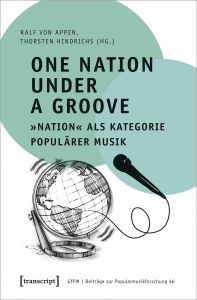One Nation Under a Groove. »Nation« als Kategorie populärer Musik. (Beiträge zur Popularmusikforschung, vol. 46). Ed. Ralf von Appen and Thorsten Hindrichs. 2020. Bielefeld: Transcript Verlag.
The theme of this multiauthor volume, which presents lectures from the 29th Annual Conference of the German Society for Popular Music Studies, hits a socio-political nerve for more reasons than just the increasingly nation-centred coronavirus mitigation strategies. Its editors, the Mainz-based musicologist Thorsten Hindrichs and Ralf von Appen of the mdw, have chosen a decidedly political focus—and they explain the decision to centre the category of “nation” on the grounds that “nationalism and right-wing populism have once again become capable of garnering majority support in a great many of the world’s countries” (8).

This volume’s individual articles, however, deal primarily with music that refers to the nation as a cliché by virtue of its name and/or genre. Alongside numerous interesting details, we learn that appeals to a nation (and/or a region or a mythological lineage) are used primarily to increase musical products’ sales. Contributions on Italo disco, the image of Ireland conveyed by German folk rock songs, technological precision work from the Black Forest, French chansons, and “Teutonic Metal” provide an extensive look at such strategies. Furthermore, a paper on hip-hop within the charged landscape of Austrian party politics and regional belonging as well as a text that deals with strategic ignorance of knowledge as a phenomenon in pop music contexts round out this collected volume.
I would like to make special mention, however, of Magdalena Fürnkranz’s central contribution on the current significance of Austropop. In her analysis of Austropop’s historical roots and its revival as the “Great Austrian Songbook”, Fürnkranz is the only author here who succeeds in unearthing deeper connections between the categories of “nation”, “popular music”, and “gender”. In doing so, she abandons the level of clichés and hints at how nationalism’s various mechanisms should be investigated in the context of identities that end up being essentialised via culture.
Her two initial theory-centred chapters, which approach the concept of “nation” and “nationalism” topologically and then historically, provide some good places to start. One is tempted to ask, however, why present-day nationalism—which does, a number of discontinuities notwithstanding, exhibit quite a few continuities with “classic nationalism” (see Gingrich 2006)—is conceptualised as post-nationalism but also characterised as something of a backlash.
Altogether, this publication most certainly does help to shed more light on the political dimensions of popular music. However, an analysis of the relationship between popular music and nationalisms that seeks to do full justice to the editors’ committed aspirations would benefit from additionally considering the concepts of ethnicity, identity, and culture as equally important elements—ideally doing so in a transdisciplinary manner. And for that, this book does indeed offer a promising basis for further work.
Gingrich, Andre (2006). “Neo-nationalism and the reconfiguration of Europe”. In Social Anthropology 14, 2, 195–217.

